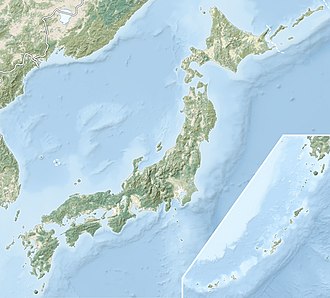Top Qs
Timeline
Chat
Perspective
2001 Geiyo earthquake
Earthquake in Japan From Wikipedia, the free encyclopedia
Remove ads
The 2001 Geiyo earthquake (2001年芸予地震 Nisen-ichi-nen Gēyo Jishin) occurred with a magnitude of MJMA 6.7 on March 24 at 15:27:53 JST, and an epicenter located near the Geiyo Islands of Hiroshima, Japan.[2]
Remove ads
Tectonic setting
This section needs expansion. You can help by adding to it. (February 2025) |
Near the Geiyo region, a Ms 7.8 earthquake occurred in June 1905,[3] which was an intraslab event within the subducting Philippine Sea plate.[4]
Earthquake
Summarize
Perspective
The United States Geological Survey (USGS) gave the earthquake a magnitude of Mw 6.8, while the Japan Meteorological Agency (JMA) reported the magnitude at MJMA 6.7, with its epicenter located near the island of Kurahashi-jima in Kure, Hiroshima Prefecture.[2][5] The released seismic moment of the earthquake was 1.3×1019 Nm. This earthquake is a normal faulting intraslab event within the subducting Philippine Sea plate.[6] The slip of the earthquake was estimated to be about 1.5–2.4 meters (4 ft 11 in – 7 ft 10 in). The locations of aftershocks were distributed roughly in N–S direction.[7] It has been suggested that this earthquake was related to the dehydration of the Philippine Sea plate slab.[8]
Intensity
The JMA reported it recorded a maximum seismic intensity of Shindo 6- on its seismic intensity scale; the maximum intensity was reported in Higashihiroshima, Ōsakikamijima and Kumano, Hiroshima Prefecture. Shindo 5+ was recorded in parts of Ehime and Yamaguchi Prefectures, while Shindo 5- was observed in multiple areas of Shimane, Kōchi and Ōita Prefectures; Shindo 1-4 was also reported in Kyushu, Kansai and Chūbu regions, with shaking recorded as far away as Shizuoka, Noto, Ishikawa, Iizuna and Kōzushima, Tokyo.[5] A maximum peak ground acceleration of 832 gal (0.85 g) was recorded at Saeki-ku, Hiroshima; strong ground motions from the earthquake were amplified and spread to areas far from the epicenter, due to the ground beneath the region comprising soft sediments.[9] On the Modified Mercalli intensity scale, the earthquake registered a maximum intensity of IX (Violent).[1] Tremors were also felt along the eastern and southern coasts of South Korea.[10]
Remove ads
Impact
Two people were killed; one in Kure, Hiroshima due to a wall collapse and the other in Matsuyama, Ehime after being hit by falling roof tiles.[11][10] Additionally, 288 others were injured, 43 of them seriously, including 183 in Hiroshima, 75 in Ehime, 12 in Yamaguchi, 4 in Kochi, 3 in Shimane and 1 in Okayama. The earthquake destroyed 76 homes, severely damaged 865 and partially damaged 53,243 others, with all structural collapses occurring in Hiroshima, Ehime and Yamaguchi; landslides destroyed 39 homes, mostly in Hiroshima. Additionally, 40,739 waterways, 1,209 cultural and educational facilities, 787 roads, 149 harbors, 97 hospitals, 9 bridges, 8 public buildings and 71 other structures were also affected.[12]
In Hiroshima, over 3,700 buildings were damaged,[2] train lines were suspended, Hiroshima Airport was temporarily closed for inspection, telecommunications were disrupted and soil liquefaction was reported.[10][13] Most of the damaged residential buildings in the city were built on steep slopes.[14] Liquefaction also occurred at Tōyo, Ehime.[15] Power outages occurred in the prefectures of Hiroshima, Ehime, Okayama, Yamaguchi, and Kōchi.[16]
See also
References
External links
Wikiwand - on
Seamless Wikipedia browsing. On steroids.
Remove ads


